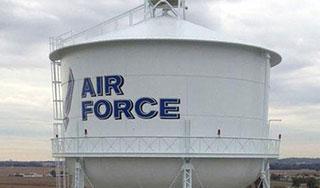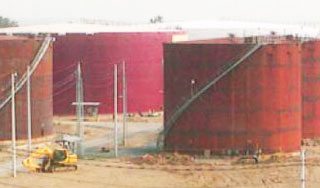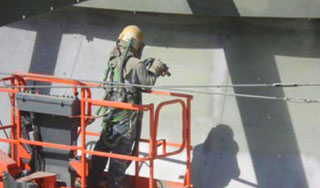Waiting until the first signs of corrosion appear on your storage tank could mean compromising both the tank and the valuable materials it contains. If rust appears beneath a tank’s protective coating, full-scale abrasive blasting will likely be called for. That’s why scheduling a tank painting with a reputable contractor, before the first sign of a problem, is so crucial to the health of your tank and its contents.
Tanks come in all shapes and sizes, with some serving very specific functions. There are elevated and ground storage tanks, standpipe tanks and bullet tanks, clarifier tanks and digester tanks, but by and large the things a contractor must consider when tank painting share some common ground: Fall protection, confined space considerations, ventilation and coating selection.
If you are the owner of a single large water tank or tower, an entire tank farm, or a wastewater treatment facility, certain jobs on an industrial painter’s resume will be of increased importance to you.
Elevated water tanks

Fall protection is the name of the game when coating the exteriors of elevated tanks. Even when painting ground storage tanks, significant heights are likely involved, especially if it’s the largest above ground potable storage tank in the United States. But when crews are moving around the exterior of a tank hundreds of feet above the ground, it is especially important to make sure a prospective contractor has the proper safety credentials.
Exterior painting jobs on elevated tanks also often include logos that act as an identifier and point of pride for a municipality or other utility. You’ll want to make sure the tank-painting contractor you’re considering has experience with such high-visibility graphics work.
Tank farms

Tank farms come standard with their own unique challenges, in addition to the ones covered above. If the tank farm is of a significant size, much larger crews will be necessary to complete the job in a timely manner.
Consider that, for the average size tank, you may have a crew of at least four working on it at any given time. While two are inside painting, one is likely to be operating a blast pot or other machinery, and one person is acting as the “hole watch,” on alert for any sign of trouble within the confined space. Multiply this by the number of tanks on the tank farm and, if the contractor is not properly staffed, owners are looking at quite a lengthy project.
Now consider how all the tanks on a tank farm are connected to each other. They are often linked by miles of pipeline and high-efficiency pumps and hydrants that also require special protection against corrosion. Suddenly, what started as a tank-painting job includes an extensive scope of work, requiring a contractor with the experience to match.
Clarifiers
Clarifier tanks at wastewater treatment plants can be harsh environments. The chemicals involved in water treatment can be especially harsh on the tank’s coatings. Additionally, the settling, raking, pumping, sludging, clarifying and filtration processes can be outright abuse on your tanks coatings, so it’s essential to get the right coating applied correctly the first time, or it simply will not last.
Why these jobs matter
These are just a few of the types of tanks that occasionally require a good coating. No contractor will have faced all the possible hurdles, but a wide range of tank painting jobs in your contractor’s portfolio will ensure that it has encountered many of the challenges inherent in these jobs.
When it has handled the dizzying heights and scrutinized graphics of elevated water tanks, the maze of pipes woven through tank farms and brutalized interior of a clarifier basin, you can be pretty sure it’s capable of adapting to the unique challenges your next job is sure to present.



